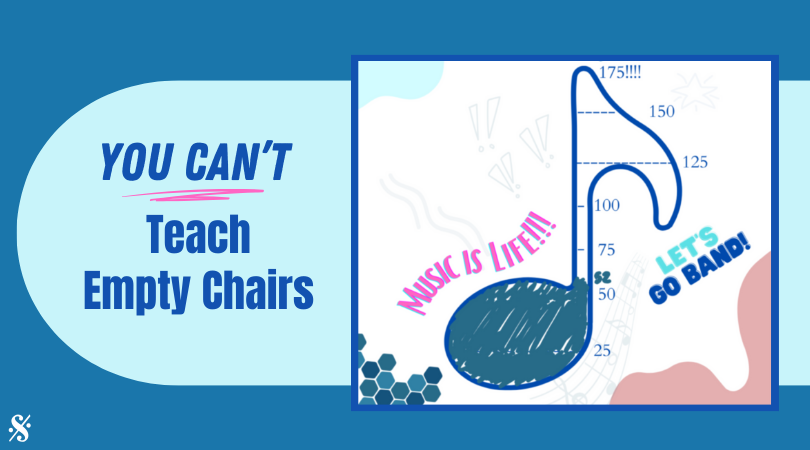
What if you could set classroom expectations in such a way that it created a class FULL of students that are enjoyable to work with, where they could run their own class, and get along without so much effort on your part? What if you could make it where you don’t dread seeing the students walk in each class period? What if you could go home at the end of the day and not feel like the kids have sapped your last bit of energy?
It is completely possible! The way you teach procedures and how you address your expectations to the students can make this all happen. If you do this from the first day, you will be able to teach your students to trust you, set them up in a routine, and turn your classes into a FUN MACHINE!
This takes some planning on your part and patience. It also will take some creativity. If something doesn’t work, don’t keep doing it. Keep changing until you find what works for your individual students. So let’s start at the beginning:
Where will they meet you?
I recommend a location outside your room, with simple instructions. For my school, we line up in the hall on their right-side wall. They will face forward, single file, and cases are in the left hand. My co-director or I stand at the start of the line facing them, to make it easy for them to remember where the line goes. We will not enter the room if there is talking. (If you are already thinking, “this will take weeks” or “they will never get silent”…keep reading. This comes down the page.)
How do they enter/where do they go when they enter?
Have their seats already assigned before the first day. We place name tags in their seats that they will turn in at the end of class every day. We put the incoming class out as the previous class is leaving. I have sorted them before school to make sure they are sitting in the order I want. I tend to change it daily to keep them from getting too comfortable too soon.
When they walk in, they are instructed to silently find their names. If someone talks, we simply start again. I don’t get upset because most teachers around the building don’t care how they enter. I need to teach a new expectation that is higher than the rest of the school. I WANT my room to be a higher level in every way. This helps them understand this place is important.
What do you want them to do with their things?
In my classroom, their personal items go under their chair. On day one, the chair is the only classroom furniture they must contend with. We will learn stands and other items when they are successfully meeting the expectations with the chairs and their personal belongings. This requires daily reinforcement because in other classes they can spread their things all around their seating area. With an extremely clumsy band director, my students need to protect their items by keeping them under their chairs. Once we add instruments to the situation, the instrument (in the case) goes to the right of their chair. This continues to keep the walkways free.
How do you start class?
We have different routines for our different level classes. In our beginner classes, the students start together, and we begin with theory and rhythm lessons that are the same for every student. Once we start getting instrument specific, we learn how to split and how to move to our respective locations. We still start every class together with rhythm learning.
For our advancing level students, we teach them how to individually warm up. This involves a set routine of long tones, slow and gentle flexibility, and scales. This requires continual reinforcement, especially for those trumpet players that want to start their day with range wars and fast fingers. If we find a younger-minded ensemble class has difficulty having this much freedom, that class may need to start with rhythm exercises to develop an expectation of a focused and calm start just like we did in beginning band. We can progress from this as they show they are ready.
Set Clear Procedures for class “interruptions”
There will be interruptions: restroom/water, pencil, valve oil, music, things left in band locker, asking questions. As those things come up, be ready with a plan for how you will deal with it and teach the plan. If you don’t have a plan, those moments will stall your class. Whatever your procedure is, make sure it is something that doesn’t require stopping class to address it. Make sure it is easy for YOU. In our room, we keep a box of extra pencils on our stand because lack of pencils can cause some of the greatest drama. Thanks to generous friends of our Amazon lists, we usually have an unending supply. There is also an instrument maintenance station in our room. If a student has an emergency, they may use it. We also employ “Maintenance Monday” in beginner class to avoid most interruptions. If a student shows that they cannot handle taking care of these things without seeking big attention, the answer will become, “I’m so sorry, you will have to wait.” Then we let them wait until the end of class that day and have them do whatever is needed at pack up time.
The End of Class
End of class procedures can be the hardest. You must give them just enough time to pack and not a second more. If they are lining up at the door, you missed a teaching opportunity AND they will likely lose decorum. Do this daily and you have set an expectation that YOUR expectations are inconsistent. If you must allow extra time due to administration requirements, then have a plan to have them seated, organized, and engaged in some way until the bell. This prevents touching, horseplay, and drama that you will have to deal with later.
Important points that Reduce struggles:
- Be specific and make it easy to remember. If you can turn things into one-word reminders, it makes it easy for you to reinforce and easier for them to remember. An example would be when we line up before class. I remind them we look for “3 S’s” (Single, Straight & Silent). Then I can ask for the THREE S’s and they can adjust quickly.
- Practice, practice, practice, and then practice these procedures some more. You are likely the first person that has ever asked them to behave in this way. They don’t have expectations like this anywhere else. If they have a hard time with it, it is simply because they really don’t know how to do it. Don’t get angry or take it personally. It’s not about you, it’s about skills they haven’t been taught. Be patient and know that you are HELPING them learn VERY IMPORTANT personal skills. These skills will last them a lifetime beyond your class!
- Don’t “Teacher-splain” or “Mom-Talk” the students when you are teaching procedures. If you nag or show frustration while teaching procedures, you are showing your weakness. When they see weakness in someone asking them to do new and hard things, they will sick on it. At this point, it becomes a game for them and you have already lost. They have learned over the years of working with other teachers that when they achieve success in frustrating the teacher, they have claimed control and they will drive that bus.
- Feel sympathy/empathy when things aren’t going well and students need to practice procedures. Say things like, “I am so sorry. Things just aren’t going well. I guess we need to start over. I’m totally bummed, but I know you can do this and your success is important to me.” Say it and MEAN it. Keep sarcasm as far from your voice as possible so they don’t feel that you are making fun of them.
- Rather than point out those doing the wrong thing, thank/reinforce the students that are doing it right. Encourage the behavior you desire. It is difficult for us to ignore bad behavior, but if the behavior isn’t putting anyone in danger, you will likely find it stops when it doesn’t get the attention it was intended to earn.
- If you HAVE TO redirect a student, make it quick, with as few words as possible (I aim for 3 or less), with as little emotion as possible. If you know the students WELL, humor can be OK here AS LONG AS it is done with few words and not directed at or belittling to that student. If you can direct the humor at yourself, that is best.
- On days when students slip up and start to show signs of complacency with procedures (it happens) don’t be afraid to default reset the class. Pack everything and reverse through your procedures until you are back at first day of school entry if necessary. Your consistency here builds trust. One day of reset can often solve weeks of issues in the future.
- Once they have the procedures down, combine procedures to streamline the process and gain class time. Once the students can line up and come into the room the right way, we have the students come straight into the room. Once this is easy, we have them come in, assemble instruments, and go to their seats. Each time you combine, you will need to teach these combined skills. It doesn’t take long, but the first few times, they will try to relax your expectations. This again, is not because of you, but because they don’t yet have the skills.
- Individual conversations can be a LIFESAVER. TRIGGER WARNING: There are many people that will disagree with me on this, however, this is one of the biggest ways I can get the toughest kids to comply. If you will speak to the student (individually) more like you would to an adult and less like a little kid, you will usually reap huge rewards. They are used to being “spoken down to” by adults. When you talk to them like they are “approaching” your age, they will usually look at you with an aura of shock. I find it really encourages most students who struggle with behavior to make a much bigger effort to conform in my classes. They feel that you are treating them with more respect than anyone else in their lives. They will try to respond by giving you more respect than they give anyone else. This may not be the level of respect that other students give you, but for that individual, it may be the first time they have tried to treat another person with respect. You then become the teacher that helps them level up in life!
- As you develop all this consistency, you are teaching students how to respond to your instruction in the future. They will believe you and with time will make a larger effort to do exactly what you ask, from the first time you introduce something, whether it be posture, embouchure, or how to effectively play a staccato note. They will take your expectations seriously with less pushback because the consistency you have shown has built a relationship based on trust and high expectations.
- Reinforce often that these expectations are because you care about them. I tell my students daily that I love them (like family) and I mean it. Some of my toughest students don’t hear this ANYWHERE else. When they know they are loved, they will do more for you than any teacher who is just teaching to a test or checking off state standards.
- Ask yourself, “How’s that working for me?” If something isn’t going the way you want it to, look at your structure in that situation and see if there is something you could adjust or change. Also ask yourself, “Am I making it about the students or about me?” I find many frustrated teachers are in some ways internalizing a situation and making it about themselves. Until they can come to terms with this and pull themselves out of it and make it solely about the students, they are probably going to be frustrated. (Remember the ”Don’t take it personally” part?)
Beware!
As you develop these expectations that create strong relationships, the other teachers are going to accuse you of a few things. Please know, these accusations are an affirmation that you are doing it right! Those accusations usually go something like this:
- “Well, only the good kids sign up for your class.” (HA! False, You made them into good kids.)
- “You are a kid whisperer.” (I guess this one isn’t completely wrong…. tell them “thank you”.)
- “Well, you just have MAGIC and it’s just not fair.” (I AM a Gryffindor, but that’s not it friend.)
- “Your subject is more fun than mine.” (I can’t really argue this one with my non-music friends, but I bet if they loved their subject as much as we music people love ours…)
Annette Mitchell is an active educator and clinician, who also likes to dabble in music education research. She is in her 25th year of teaching middle school band. All 25 years of her career have been in Low SES schools. When she is not teaching fundamentals and encouraging students to reach beyond their own expectations, she is blessed work at her primary full-time job of being a wife and mom.
Related Reading:
Classroom Management Techniques for Band Directors
Starting with Structure
Proactive Classroom Management: The Beginning of the Year
Stand Tags – For More Than Just Learning Names
If you would like to receive our weekly newsletter, sign up here.
Don’t forget to like us on Facebook too!
Learn. Share. Inspire.
BandDirectorsTalkShop.com






Leave a Reply
You must be logged in to post a comment.